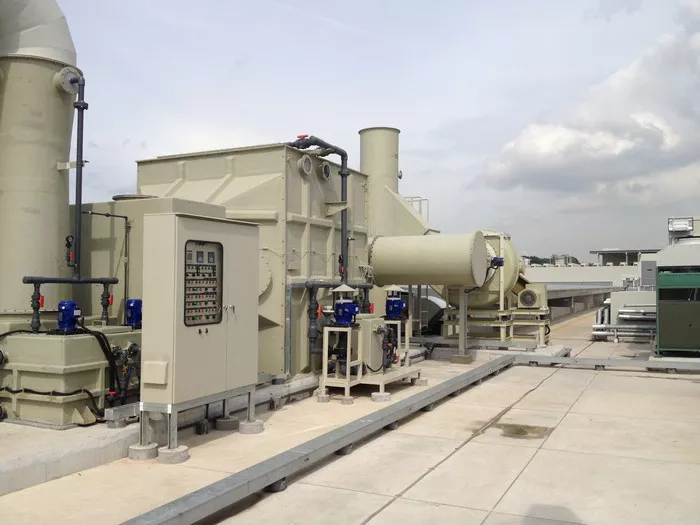Scrubber systems play a vital role in various industries, particularly in mitigating air pollution and ensuring compliance with environmental regulations. These systems utilize innovative technology to remove harmful pollutants from exhaust gases, contributing to cleaner air and a healthier environment. This comprehensive guide aims to provide a thorough understanding of how scrubber systems work, their components, and their applications across different industries.
Introduction to Scrubber Systems
Scrubber systems are air pollution control devices that utilize a liquid (often water or alkaline solutions) to remove pollutants from industrial exhaust gases. These pollutants can include particulate matter, sulfur dioxide (SO2), nitrogen oxides (NOx), volatile organic compounds (VOCs), and other harmful substances emitted from industrial processes.
Components of a Scrubber System
1. Inlet Section:
The inlet section is where the polluted gas enters the scrubber system. It typically consists of a duct or channel that directs the gas flow towards the scrubbing apparatus.
2. Scrubbing Apparatus:
The heart of the scrubber system, this component facilitates the contact between the polluted gas and the scrubbing liquid. Different types of scrubbing apparatus include packed bed scrubbers, spray towers, venturi scrubbers, and electrostatic precipitators.
3. Liquid Circulation System:
This system ensures the continuous supply of scrubbing liquid to the scrubbing apparatus. It consists of pumps, pipes, and valves that regulate the flow of liquid.
4. Outlet Section:
After the pollutants are removed from the gas stream, the clean gas exits through the outlet section. This section may include demisters or mist eliminators to remove any remaining liquid droplets from the gas.
5. Control System:
The control system monitors and regulates various parameters of the scrubber system, such as liquid flow rate, gas flow rate, pressure, and temperature. It ensures optimal performance and efficiency of the system.
Working Principle of Scrubber Systems
Scrubber systems operate on the principle of contact between the polluted gas and the scrubbing liquid, facilitating the transfer of pollutants from the gas phase to the liquid phase. The process typically involves the following steps:
1. Gas-Liquid Contact: The polluted gas enters the scrubber system and comes into contact with the scrubbing liquid. This contact can occur through various mechanisms, such as spraying the liquid into the gas stream or passing the gas through a packed bed of liquid.
2. Pollutant Absorption: Pollutants present in the gas stream dissolve or react with the scrubbing liquid. This absorption process depends on factors such as the chemical properties of the pollutants and the composition of the scrubbing liquid.
3. Formation of Scrubbing Products: Upon contact with the scrubbing liquid, pollutants undergo chemical reactions or physical absorption, forming scrubbing products. These products may be in the form of dissolved ions, particulate matter, or other compounds.
4. Separation of Clean Gas and Liquid: The clean gas, now free of pollutants, exits the scrubber system through the outlet section. Meanwhile, the scrubbing liquid, containing the absorbed pollutants, is collected and treated for disposal or recycling.
Types of Scrubber Systems
1. Wet Scrubbers:
Wet scrubbers use a liquid to remove pollutants from the gas stream. They are versatile and effective in removing a wide range of pollutants, making them suitable for various industrial applications.
2. Dry Scrubbers:
Dry scrubbers utilize dry sorbent materials to remove pollutants from the gas stream. They are particularly useful in applications where the use of liquid may not be feasible or desirable.
3. Gas Scrubbers:
Gas scrubbers are specialized scrubber systems designed specifically for removing gaseous pollutants from industrial exhaust gases. They are highly efficient in capturing gases such as sulfur dioxide, hydrogen sulfide, and ammonia.
Applications of Scrubber Systems
Scrubber systems find wide-ranging applications across various industries, including:
1. Power Plants: Scrubbers are used to remove sulfur dioxide and other pollutants from the flue gases generated by coal-fired power plants.
2. Chemical Processing: Scrubbers help control emissions of volatile organic compounds (VOCs) and hazardous air pollutants (HAPs) from chemical manufacturing processes.
3. Steel Production: Scrubbers are employed to remove particulate matter and other pollutants from the exhaust gases produced during steelmaking processes.
4. Waste Incineration: Scrubbers play a crucial role in controlling emissions from waste incineration facilities, reducing the release of harmful pollutants into the atmosphere.
Conclusion
Scrubber systems are indispensable tools in the fight against air pollution and the preservation of environmental quality. By effectively removing pollutants from industrial exhaust gases, these systems help ensure compliance with regulatory standards and promote sustainable industrial practices. Understanding the mechanics of scrubber systems, including their components, working principles, and applications, is essential for implementing efficient pollution control strategies across various industries.
FAQs
Q1. How do scrubber systems remove pollutants from industrial exhaust gases?
A1: Scrubber systems utilize a liquid (water or alkaline solutions) to remove pollutants from industrial exhaust gases. The polluted gas comes into contact with the scrubbing liquid, allowing pollutants to dissolve or react with the liquid. This process facilitates the transfer of pollutants from the gas phase to the liquid phase, effectively removing them from the gas stream.
Q2. What are the different types of scrubber systems?
A2: There are several types of scrubber systems, including wet scrubbers, dry scrubbers, and gas scrubbers. Wet scrubbers use a liquid to remove pollutants, while dry scrubbers utilize dry sorbent materials. Gas scrubbers are specialized systems designed for removing gaseous pollutants from industrial exhaust gases.
Q3. What industries commonly use scrubber systems?
A3: Scrubber systems are commonly used in industries such as power generation, chemical processing, steel production, and waste incineration. They are employed to control emissions of pollutants such as sulfur dioxide, nitrogen oxides, volatile organic compounds, and particulate matter, ensuring compliance with environmental regulations and promoting cleaner air.

